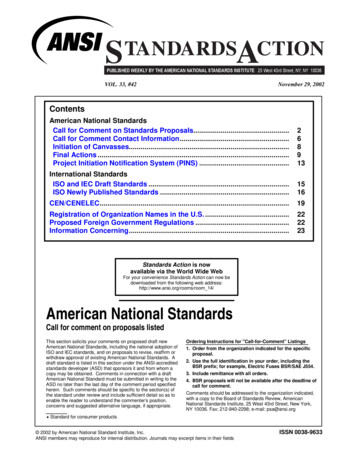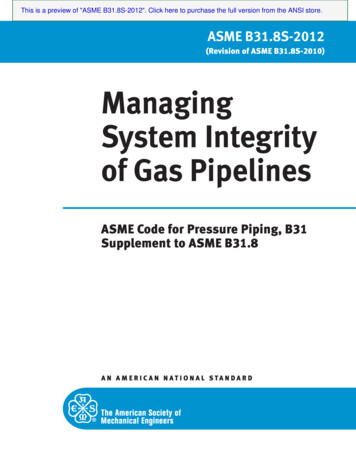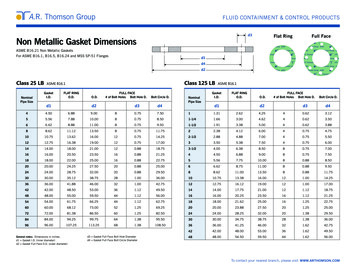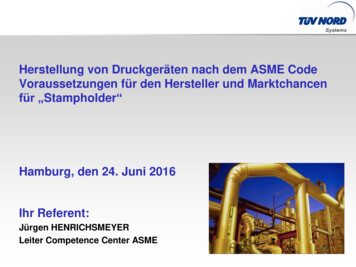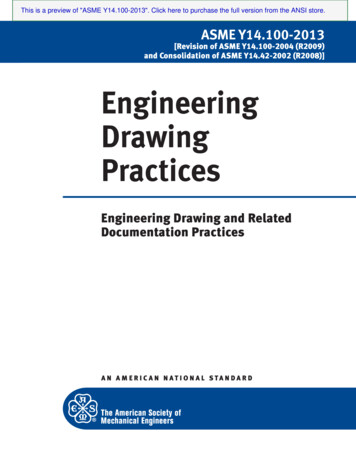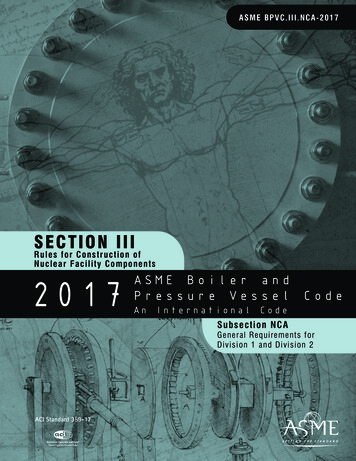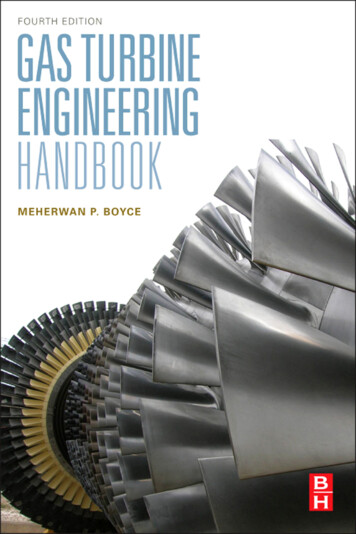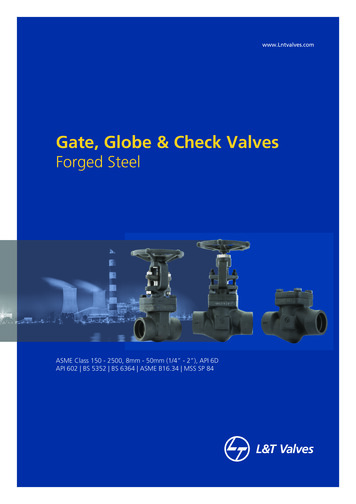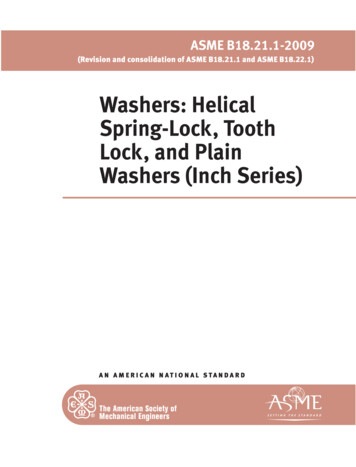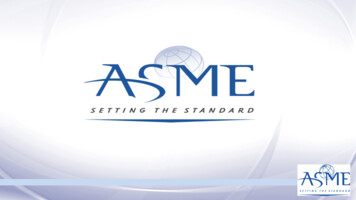
Transcription
ASME Additive ManufacturingStandardsNovember , 2017Kathryn HyamProject Engineering ManagerASME Nuclear and Standardization S&CAdditive Manufacturing For Reactor Materials & ComponentsCat 3 Public MeetingNovember 28-29 2017
New Activities Related to Manufacturing Y14.46 – Product Definition for Additive Manufacturing Y14.47 - Model Organization Schema Practices Y14.48 - Universal Direction and Load Indicators B46 - Classification and Designation of Surface Qualities – for itemsmade by additive manufacturing B89.4.23- 201x X-ray Computed Tomography (CT) PerformanceEvaluation Standard V&V 50 – Verification and Validation in Computational Modeling forAdvanced Manufacturing Model Based Enterprise (MBE) Pressure Retaining Equipment – Additive Manufacturing
Y14 Engineering Product Definition and RelatedDocumentation Practices Charter: The development and maintenance of national standards fordefining and documenting a product throughout its life cycle andrelated certification activities. This shall be accomplished by:1. recognizing the continuing need for existing standards regardless of thesource medium (e.g., paper, film, and digital) or method of preparation(e.g., manual or computer generated);2. providing standardization where a variety of practices exist within industryand government;3. providing standards for new concepts and technologies; and4. supporting and coordinating development and harmonizing of standardswith responsible standardization bodies, including ANSI, ISO, andgovernment agencies.
Y14.46 – Product Definition for Additive Manufacturing Charter: Standardization of dimensioning and tolerancing methods,systems, and indications on engineering product definition digitaldata sets promotes uniform practices and should facilitate a commoninterpretation of these requirements Subcommittee formed in in October 2014 25 members from throughout industry and academia, withcollaborating government agencies: NISTUS ArmyNAVAIROffice of Naval Research
Y14.46 – Product Definition for Additive Manufacturing Supplements the requirements of Y14.5 and it addresses methods tocontrol the product definition for Additive Manufacturing such assupporting structures, assemblies, embedded components, testcoupons and heterogeneous materials. The standard establishesmethods to specify AM process specific characteristics (e.g. buildorientation and placement) that affect the product definition. Document was recently published as a DRAFT STANDARDS FOR TRIALUSE. A free Webinar is scheduled for January 10, 2018 on the ence/Y1446JAN18
Y14.47 - 3D Model Data Organization Schema Practices The Standard establishes a schema for organizing information in amodel within a digital product definition data set when conveying theproduct definition in a Model Based Enterprise (MBE). The schemadefines a common practice to improve design productivity and todeliver consistent data content and structure to consumers of thedata. This schema document was developed to provide a set of referencestandards and guidelines for the CAD user. The Draft is based onAppendix B of MIL-STD-31000A, Technical Data Packages (TDP). The need for this standard was identified in the ANSI/America Makesgap analysis.
Y14.47 - 3D Model Data Organization Schema Practices The Subcommittee was formed in October 2013. There are 23 members on the subcommittee. The document has been Standards Committee approved butrecently received a Public Review comment. Subcommittee met inOctober 2017 and has prepared a resolution of the comments. Willbe balloted again. Once ANSI approved, this standard is expected to be published inthe first half of 2018.
Y14.48 - Universal Direction and Load Indicators Charter: Standardization of methods to unambiguously define and specifydirections, directional requirements, loads, and loading requirements inproduct definition data sets. The standard will add more tools for the designer to address direction ontheir drawing and model (e.g., direction of the Additive Manufacturebuild). Subcommittee formed in October 2016 Eight Members on the Subcommittee Held their first face-to-face SC meeting in October 2017 An initial draft was prepared by a volunteer and will be reviewed by thesubcommittee.
B46 - Classification and Designation of Surface Qualities B46.1 defines surface texture and its constituents: roughness,waviness and lay, and parameters for quantifying surface texture. The terms and ratings in this standard relate to surfaces producedby such means as abrading, casting, coating, cutting, etching, plasticdeformation, sintering, wear, erosion, etc. The current measurement and analysis methods were developedprimarily to characterize surfaces created by conventionalmachining and grinding. The surfaces created by AdditiveManufacturing have distinctly different geometric characteristics.
B46 - Project Team 53Surface Finish for Additive Manufacturing Formed in October 2015 in response to an identified need noted inthe ANSI/America makes gap analysis. A survey was sent to related ASME committees and other requestinginput on Surface Finish needs in the Additive Manufacturing field. TheSurvey results have been compiled and are being analyzed. The Project Team usually hold two face-to-face meetings a year andteleconference in between meetings Work is currently focused on two documents: White paper andFunctional Correlation document
B89 – Dimensional Metrology Charter: The calibration, performance evaluation, uncertaintyevaluation, and specification of dimensional measuring instrumentsand gages and the methods of their use for measuring variousgeometrical characteristics such as lengths, plane surfaces, angles,circles, cylinders, cones, spheres, and tori, as well as profiles. Standards, Guidelines and Technical Papers on the following: B89 Division 1 - LengthB89 Division 3 - GeometryB89 Division 4 - Coordinate Measuring TechnologyB89 Division 5 - General Principles and DefinitionsB89 Division 6 - EnvironmentB89 Division 7 - Measurement Uncertainty
B89.4.23 - X-ray Computed Tomography (CT)Performance Evaluation Standard This standard specifies the dimensional measurement accuracy of X-raycomputed tomography (CT) systems for point-to-point lengthmeasurements of homogeneous materials. The Standard is applicable to dimensional measurements made at thesurface of the workpiece, i.e. at the workpiece material – air interface,including those of internal cavities. The evaluation of workpiecescomposed of multiple materials or of “density gradient” measurements,e.g., gradual density variations within the material, is outside the scope ofthis Standard. The document is approximately 85-90% complete and should be ballotedafter the next face-to-face meeting in April 2018.
Verification & Validation of Computational Modeling Charter: Coordinate, promote, and foster the development ofstandards that provide procedures for assessing and quantifying theaccuracy and credibility of computational models and simulations. V&V Subcommittees1.2.3.4.5.6.V&V 10 Verification and Validation in Computational Solid MechanicsV&V 20 Verification and Validation in Computational Fluid Dynamics and HeatTransferV&V 30 Verification and Validation in Computational Simulation of Nuclear SystemThermal Fluids BehaviorV&V 40 Verification and Validation in Computational Modeling of Medical DevicesV&V 50 Verification and Validation of Computational Modeling for AdvancedManufacturingV&V 60 Verification and Validation of Computational Modeling in Energy Systems
V&V 50 – Computational Modeling for AdvancedManufacturing Charter: To provide procedures for verification, validation, and uncertaintyquantification in modeling and computational simulation for advancedmanufacturing. Subcommittee was formed in March 2016 and currently about 33 membersincluding members from FDA, FAA, and NASA, as well as major National Labs V&V 50 Subgroups – recently formed on:1. Terminology, Concepts, Relationships and Taxonomy for VVUQ in AdditiveManufacturing2. V&V Interactions with the Model Life Cycle3. VVUQ Challenges and Methods in Systems of Models4. VVUQ Methods in Data-driven and Hybrid models5. VVUQ Applications in Process Technologies
Model Based Enterprise (MBE) Proposed Charter: Development of standards that provide rules,guidance, and examples for the creation and use of model-baseddigital datasets, data models, and related topics within a ModelBased Enterprise (MBE). Concern use of the model from cradle to grave – from the conceptstage, through design, to manufacturing, inspection, to customerfeedback and retirement The MBE effort supports Additive Manufacturing
Pressure Retaining Equipment – Additive Manufacturing The Board on Pressure Technology Codes & Standards (BPTCS) andthe Board on Nuclear Codes and Standards (BNCS) have identified thepotential need/use of Additive Manufacturing (3D Printing) as aprocess for the construction of pressure equipment. BPTCS/BNCS have formed a Special Committee on Use of AdditiveManufacturing for Pressure Equipment
Questions?
Y14.46 – Product Definition for Additive Manufacturing Supplements the requirements of Y14.5 and it addresses methods to control the product definition for Additive Manufacturing such as supporting structures, assemblies, embedded components, test coup

